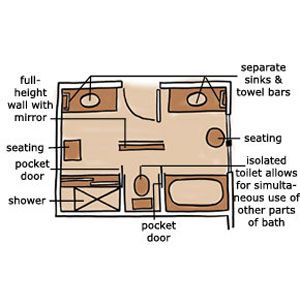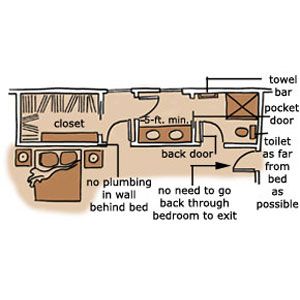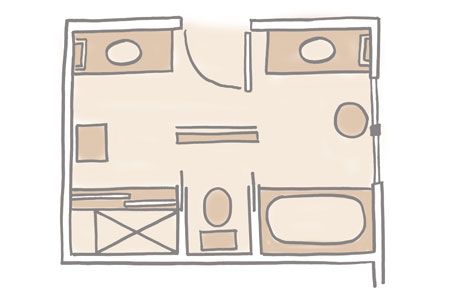Accommodating the daily personal hygiene routines of two people in a limited space can be challenging, but with the right approach, it’s possible to create a functional and harmonious shared bathroom. This guide will explore strategies and design techniques to make your double-use bath work efficiently for both partners.
Dealing with a Tight Squeeze
Even in compact spaces, clever design can make a bathroom feel more spacious. The following design principles can transform cramped quarters:
Mirrors: Wall-to-wall and wainscot-to-ceiling mirroring amplifies light and visually doubles the space, creating an illusion of openness in tight quarters. Mirrored cabinetry can create this effect while also adding extra storage space.
Vaulted Ceilings: If possible, consider raising your ceiling to the rafters. Increased vertical space can make a room feel airier and less cramped.
Windows: Installing a window above the toilet or between double sinks will introduce natural light and create a connection to the outdoors. If you are concerned about someone looking in, frosted glass or a well-placed shrub will increase privacy.
Let There Be Light (And Air!)
Lighting and ventilation are key to improving comfort in a tight bathroom.
Lighting: The more natural light, the better. The best light for a bath comes from above–skylights or transom/clerestory windows. Above-eye-level openings provide privacy and maximize the effect of light by bouncing it off the ceiling. When windows or skylights are not an option, artificial light must suffice. Overhead lighting produces unflattering shadows. The best artificial light for grooming at a mirror comes from eye level, so wall sconces are ideal.
Ventilation: Bathrooms experience dramatic microclimate changes, from steamy showers to less pleasant odors. Proper ventilation is non-negotiable in a bath shared by two people. While operable windows or skylights help in fair weather, mechanical assistance is often necessary. It is ideal to have two exhaust fans–one near the toilet and another by the shower. This ensures efficient air circulation and humidity control. A timer or humidity sensor can also help maintain a fresh and mold-free environment.

Pay Attention to Schedules
The way couples use their shared bathroom falls into two categories: those who get ready simultaneously and those with different schedules.
For couples who prepare for their day concurrently, certain features are essential:
- Dual sinks: Allow at least a 5-foot run of counter for shared vanities or 3 feet for each sink if they’re freestanding. This setup provides ample space for both partners to perform their morning routines.
- Separate zones: Create distance between the toilet and shower area (at least 5 feet) to avoid congestion.
- Customized vanities: Tailor different setups based on individual needs, such as a larger vanity/makeup station for the partner who spends more time primping.
When partners have varying routines, the focus shifts to minimizing disturbances:
- Sound buffering: Place a closet or dressing area between the bathroom and bedroom to reduce noise transfer. Additional soundproofing measures, such as insulated walls and soft-closing doors, can further enhance quietness.
- Alternative exit: Include a “back door” allowing bathroom users to leave without re-entering the bedroom.
- Compact design: These bathrooms can be smaller than simultaneous-use baths, but require more attention to soundproofing.
Selecting Fixtures
A shared bathroom must accommodate the different physical characteristics of its users. When negotiating which fixtures to install, consider:
- Adjustable features: If you and your partner have a significant height difference, choose adjustable showerheads or dual-height towel bars.
- Compromise on heights: Set sinks, towel rods, and toilet seats to a mean height that works reasonably well for both users.
- Specialized products: Look into elongated or comfort-height toilets that cater to different body types.
- Custom vanities: Consider separate vanity heights if the difference is substantial.

Prioritize and Multitask
When renovating a small bathroom, setting priorities is crucial.
- Bathtub or shower: Determine if a bathtub is necessary or if a space-saving shower suffices. Evaluate your lifestyle and preferences to make an informed decision that best suits your needs.
- Optimize counter space: One sink in a 4-foot vanity might provide more usable space than two sinks in a 6-foot vanity. Consider the trade-offs and choose a layout that offers the most practical solution.
- Clever accessories: Install a fog-free mirror in the shower for multitasking. This allows for efficient use of time and space, making your morning routine smoother.
- Consider a urinal: A discreetly placed urinal can be convenient for couples who get ready simultaneously.
- Strategic bidet placement: If only one partner uses the bidet, place it on their side of the bathroom for easier access.
- Shared relaxation: If installing a steam shower, make it large enough for two to enjoy together.
Personalization
While functionality is crucial, don’t forget to infuse some personality into your shared bathroom. Personal touches make a space feel more welcoming and comfortable.
- Color coordination: Choose a neutral base color and allow each partner to add personal touches with accessories in their preferred colors. This approach provides a cohesive look while honoring individual preferences.
- Bespoke towels: Use different colored or monogrammed towels for each user. This simple touch can add a sense of individuality and organization.
- Artwork: Select art pieces that reflect both partners’ tastes or compromise with prints that appeal to both.
- Plants: Introduce low-maintenance, bathroom-friendly plants to add life and improve air quality.
Our Conclusion
Creating a harmonious shared bathroom is about balancing functionality, personal preferences, and clever design. By considering schedules, physical needs, and incorporating smart storage solutions, you can make a small space comfortable for two. The key to a successful shared bathroom is open communication and compromise between partners. Whether you’re designing from scratch or renovating an existing space, thoughtful planning and attention to detail can create a shared bathroom that meets the needs and preferences of both users.

